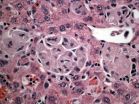(Press-News.org) URBANA – University of Illinois scientists think they have solved an interesting problem: how to get protein-deficient Indian schoolchildren to consume soy, an inexpensive and complete vegetable protein. What's more, they've joined forces with an Indian foundation that can get the high-protein soy snack they've developed into the hands of 1.2 million hungry kids who need it.
"Although the country has decidedly vegetarian tastes, the Indian people just don't care for soy," said Soo-Yeun Lee, a U of I associate professor of food science and human nutrition.
India is one of the world's top five soy producers, but the country exports most of its crop, keeping only the oil for domestic consumption. That's unfortunate because 24 percent of India's population is undernourished, and protein deficiency is an even greater concern. Eating more soy could help to alleviate that problem, the researcher said.
Because Indians are avid snackers, Lee and her U of I colleagues experimented with nine soy snack recipes, running into minor bumps along the way due to the ability of soy protein to bind flavors, which causes flavor fade and makes the soy taste more pronounced.
The extrusion process the food scientists were using also increased the snack's hardness when more protein was added.
Those problems solved, Lee and her colleagues moved onto the next phase of the project—consumer taste tests. Seventy-two members of a surrogate Indian population in the Champaign-Urbana area were asked to participate in a sensory panel.
Snacks that were crunchy, salty and/or spicy, and contained umami, cumin, and curry flavors received high marks from participants. Panelists turned thumbs down on snacks with rougher, porous textures and wheat flavor and aroma.
The soy snacks were then given to a 62-member sensory panel recruited at the International Society for Krishna Consciousness Temple in Bangalore, India.
The final formulation included chickpea flour, a staple in Indian cuisine that provides a preferred texture and flavor, and such spices as cumin and red chili pepper.
The U of I scientists began working with Bangalore's Akshaya Patra Foundation, a non-governmental organization that runs one of the largest school meal programs in the world. The foundation now feeds over 1.2 million underprivileged Indian children a day.
"A free school lunch is a powerful incentive for Indian children to attend school. When families are living in poverty, parents often keep their kids at home because they're more valuable there doing chores or selling goods on the streets," Lee said.
Not only that, research shows a correlation between school lunches that are high in protein and increased student performance. Having a protein deficiency at an early age can also cause future medical problems, so providing enough protein for these children who are hungry and getting just one meal per day at school is important, she added.
The foundation has acquired an extruder so they can make the snacks for their school lunch program and, as further testimony of the recipe's likability, sell them in the temple gift shop, she said.
"I'd have to say that our attempts to make a soy snack that appealed to Indian tastes were pretty successful. Sensory scientists are important for their ability to make nutritious foods bridge cultural divides," she said.
###The research is described in articles in the August 2010 issue of Journal of Food Science and the July 2010 issue of the Journal of Sensory Science. Co-authors of both papers are former U of I graduate student Erika A. Neely, now with General Mills, and Youngsoo Lee, a U of I research assistant professor.
Research was funded in part by the National Soybean Research Laboratory (NSRL), Illinois soybean checkoff dollars provided by the Illinois Soybean Association, and the Akshaya Patra Foundation, and was made possible by the collaborative efforts of Vijaya Jain and Bridget Owen of NSRL. Former NSRL associate director Pradeep Khanna, now U of I associate vice chancellor for public engagement, also helped to lay the groundwork for this research.
END
Washington, D.C. (October 19, 2010) -- In the world of the very small, researchers at Shanxi University in China have announced progress in understanding the single-molecule magnet, which combines the classical macroscale properties of a magnet with the quantum properties of a nanoscale entity. In the Journal of Applied Physics, Hai-Bin Xue and colleagues studied the statistics of how electrons move through a single-molecule magnet to better understand the magnet's inner level structure.
Understanding the single-molecule magnet inner level structure is an important step ...
In a world first, a completely robotic surgery and anesthesia has been performed at the McGill University Health Centre (MUHC). The DaVinci surgical robot, which lets surgeons work from remote locations, was put to work this summer, whereas the anesthesia robot, nicknamed McSleepy, has been providing automated anesthesia since 2008. The two combined to perform the first all-robotic surgery on a prostatectomy patient at the Montreal General Hospital.
"Collaboration between DaVinci, a surgical robot, and anesthetic robot McSleepy, seemed an obvious fit; robots in medicine ...
Princeton engineers have developed a sensor that may revolutionize how drugs and medical devices are tested for contamination, and in the process also help ensure the survival of two species of threatened animals.
To be fair, some of the credit goes to an African frog.
In the wild, the African clawed frog produces antibacterial peptides -- small chains of amino acids -- on its skin to protect it from infection. Princeton researchers have found a way to attach these peptides, which can be synthesized in the laboratory, to a small electronic chip that emits an electrical ...
Outgoing. Assertive. Calm. Practical. Decisive. These are obvious qualities that one would want in their leaders.
But what about, say, arrogant, hesitant, overly dramatic, inflexible, or being a "yes-man"? A new study has found that when it comes to leading, some of those negative personality traits aren't such a bad thing, either.
The work, by researchers in the University of Nebraska-Lincoln's College of Business Administration, studied the development of leaders over a three-year period. Prior research had established that clearly positive personality qualities ...
WASHINGTON, D.C., October 19, 2010—In response to a study regarding fish oil use during pregnancy published in the October 19 issue of the Journal of the American Medical Association (JAMA), the Council for Responsible Nutrition (CRN), the leading trade association for the dietary supplement industry, reminds pregnant and lactating women of the undisputed importance of consuming the recommended amounts of docosahexaenoic acid (DHA) throughout pregnancy. This can be done by eating two servings of fatty fish, such as sardines or anchovies, per week, or taking fish oil supplements ...
The 2010 Nobel Prize in Physics went to the two scientists who first isolated graphene, one-atom-thick crystals of graphite. Now, a researcher with the University of Houston Cullen College of Engineering is trying to develop a method to mass-produce this revolutionary material.
Graphene has several properties that make it different from literally everything else on Earth: it is the first two-dimensional material ever developed; the world's thinnest and strongest material; the best conductor of heat ever found; a far better conductor of electricity than copper; it is virtually ...
Athens, Ga. – When we make decisions based on what we think someone else will do, in anything from chess to warfare, we must use reason to infer the other's next move—or next three or more moves—to know what we must do. This so-called recursive reasoning ability in humans has been thought to be somewhat limited.
But now, in just-published research led by a psychologist at the University of Georgia, it appears that people can engage in much higher levels of recursive reasoning than was previously thought.
"In fact, they do it fairly easily and automatically," said Adam ...
ANN ARBOR, Mich. – Millions worldwide die each year because they can't afford a pacemaker. Meanwhile heart patients in the United States say they'd be willing to donate theirs after death to someone in need.
In the current issue of Circulation, experts at the University of Michigan Cardiovascular Center examine the legality and logistics of collecting pacemakers, after they are removed for burial or cremation, for sterilization and reuse across the globe.
Small humanitarian efforts have shown reusing pacemakers is safe and effective with little risk of infection and ...
Researchers at Yale School of Medicine have found that new disease pathways involving more than one cell type leads to Type 1 Gaucher disease, a rare genetic disorder in which fatty substances called glycosphingolipids accumulate in cells, resulting in liver/spleen enlargement, osteoporosis, bone pain, and increased risk of cancer and Parkinson's disease.
The new findings could lead to less expensive and more effective ways to treat the disorder, which affects about 1 in 50,000 people in the general population. Those of Eastern and Central European (Ashkenazi) Jewish ...
A new report issued by the International Osteoporosis Foundation (IOF) for World Osteoporosis Day puts the spotlight on the severe impact of spinal fractures and calls on health professionals to recognize the signs of these fractures in their patients.
"The widespread under–diagnosis and lack of treatment of spinal fractures, leaves millions of people around the world with chronic pain, deformity, disability and at high risk of future fractures," says Professor John Kanis, President of the IOF.
As many as two-thirds of spinal osteoporotic fractures are not recognized ...


